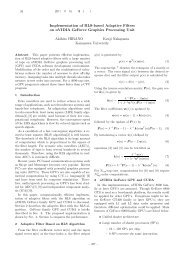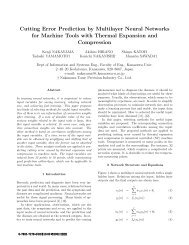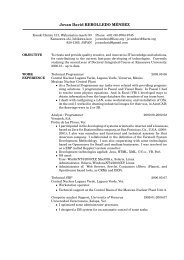a synchronized learning algorithm for nonlinear part in a lattice ...
a synchronized learning algorithm for nonlinear part in a lattice ...
a synchronized learning algorithm for nonlinear part in a lattice ...
You also want an ePaper? Increase the reach of your titles
YUMPU automatically turns print PDFs into web optimized ePapers that Google loves.
Output Error[dB]<strong>part</strong>s. The <strong>learn<strong>in</strong>g</strong> curve of ’Synchronized(L)’ is almostthe same as that of ’Asynchronous’. On the contrary,the <strong>synchronized</strong> <strong>learn<strong>in</strong>g</strong> <strong>algorithm</strong> <strong>for</strong> both the l<strong>in</strong>earand <strong>nonl<strong>in</strong>ear</strong> <strong>part</strong>s, shown with ’Synchronized(L+NL)’,can improve the <strong>learn<strong>in</strong>g</strong> curve by 15dB.Figure7 shows the <strong>learn<strong>in</strong>g</strong> curves <strong>for</strong> the nonstationarycolored signal, which is generated through the2nd-order AR model, whose pole oscillates around π/4by ±20% with a period of 500 samples. In this case,also the <strong>synchronized</strong> <strong>learn<strong>in</strong>g</strong> <strong>algorithm</strong> <strong>for</strong> both thel<strong>in</strong>ear and <strong>nonl<strong>in</strong>ear</strong> <strong>part</strong>s is superior to the others. Inthis figure, ’Synchronized(L)’ is not shown, because it isalmost the same as ’Asynchronous’.Furthermore, the <strong>learn<strong>in</strong>g</strong> curves <strong>for</strong> another nonstationarycolored signal are shown <strong>in</strong> Fig.8. The poleof the 2nd-order AR model oscillates around π/4 by±100% with a period of 500 samples. In this case, thereflection coefficients change more rapidly compared tothe previous example. For this reason, the convergencebecomes a little slower than the previous. Still, the <strong>synchronized</strong><strong>learn<strong>in</strong>g</strong> <strong>algorithm</strong> can improve the convergenceproperty.100-10-20-30-40-50-60-70Synchronized(L)Synchronized(L+NL)Asynchronous-800 20000 40000 60000 80000 100000 120000 140000 160000 180000 200000Iteration[sample]Figure 6: Learn<strong>in</strong>g curves <strong>for</strong> LP-AVF us<strong>in</strong>g stationarycolored signal. Synchronized(L) and Synchronized(L+NL)means <strong>synchronized</strong> <strong>learn<strong>in</strong>g</strong> <strong>algorithm</strong>s<strong>for</strong> l<strong>in</strong>ear <strong>part</strong> and l<strong>in</strong>ear and <strong>nonl<strong>in</strong>ear</strong> <strong>part</strong>s, respectively,are used.Output Error[dB]100-10-20-30-40-50-60-70-800 20000 40000 60000 80000 100000 120000 140000 160000 180000 200000Iteration[sample]AsynchronousSynchronized(L+NL)Figure 7: Learn<strong>in</strong>g curves <strong>for</strong> LP-AVF us<strong>in</strong>g nonstationarycolored signal. Pole of 2nd-order AR model oscillatesaround π/4 by 20% with period 500 samples.Output Error[dB]0-10-20-30-40-50-60-70Synchronized(L+NL)-800 20000 40000 60000 80000 100000 120000 140000 160000 180000 200000Iteration[sample]AsynchronousFigure 8: Learn<strong>in</strong>g curves <strong>for</strong> LP-AVF us<strong>in</strong>g nonstationarycolored signal. Pole of 2nd-order AR model oscillatesaround π/4 by 100% with period of 500 samples.6. CONCLUSIONSSeveral k<strong>in</strong>ds of whiten<strong>in</strong>g methods <strong>for</strong> the adaptiveVolterra filter have been compared. The <strong>lattice</strong> predictorbased AVF is superior to the others. Convergenceproperty of the asynchronous LP-AVF has beenanalyzed. Furthermore, the <strong>synchronized</strong> <strong>learn<strong>in</strong>g</strong> <strong>algorithm</strong><strong>for</strong> the <strong>nonl<strong>in</strong>ear</strong> <strong>part</strong> of the LP-AVF has beenproposed, and its usefulness has been confirmed throughseveral simulations us<strong>in</strong>g stationary and nonstationarycolored signals.REFERENCES[1] V. J. Mathews, ”Adaptive polynomial filters,” IEEESignal Process<strong>in</strong>g Mag., pp. 10-26, July 1991.[2] A.Stenger, L.Trautmann and R.Rabenste<strong>in</strong>, ”Nonl<strong>in</strong>earacoustic echo cancellation with 2nd order adaptiveVolterra filters,” IEEE Proc. ICASSP’99, AE1.7,pp877-880, 1999.[3] B.S.Nollett and D.L.Jones, ”Nonl<strong>in</strong>ear echo cancellation<strong>for</strong> hands-free speakerphones,” 1997 IEEE Workshopon Nonl<strong>in</strong>ear Signal and Image Proc[4] J.Lee and V.J.Mathews, ”A fast recursive least squaresadaptive second order Volterra filter and its per<strong>for</strong>manceanalysis,”IEEE Trans on Signal Process<strong>in</strong>g,Vol.41, No.3, pp.1087-1102, Mar 1993.[5] A.Strenger and W.Kellermann, ”Nonl<strong>in</strong>ear acousticecho cancellation with fast converg<strong>in</strong>g memoryless preprocessor,”Proc. IEEE Workshop on Acoustic Echoand Noise Control, Pocono Manor, PA, USA, September,1999.[6] X.Li and W.K.Jenk<strong>in</strong>s, ”Computationally efficient <strong>algorithm</strong>s<strong>for</strong> third order adaptive Volterra filters,” IEEEProc. ICASSP’98, DSP5.3, 1998.[7] S.Hayk<strong>in</strong>, Adaptive Filter Theory, 3rd Ed., PrenticeHall Inc., New York, 1996.[8] N.Tokui, K.Nakayama and A.Hirano, ”A <strong>synchronized</strong><strong>learn<strong>in</strong>g</strong> <strong>algorithm</strong> <strong>for</strong> reflection coeffcients and tapweights <strong>in</strong> a jo<strong>in</strong>t <strong>lattice</strong> predictor and transversalfilter”, IEEE Proc. ICASSP’2001, Salt Lake City,pp.1472-1475, May 2001.[9] K.Nakayama, A.Hirano and H.Kashimoto,”A <strong>lattice</strong>predictor based adaptive Volterra filter and a <strong>synchronized</strong><strong>learn<strong>in</strong>g</strong> <strong>algorithm</strong>”, Proc., XII Europian SignalProcess<strong>in</strong>g Conference, Vienna, Austria, pp.1585-1588,Sept. 2004.






